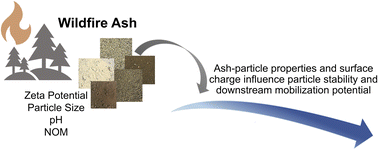Emerging investigator series: physicochemical properties of wildfire ash and implications for particle stability in surface waters
Abstract
The erosion of wildfire ash from the forest floor to nearby surface waters presents a concern due to potential contamination and alteration of water quality. Meanwhile, the properties of wildfire ash that drive ash particle stability in aquatic systems, mobilization downstream, and transport of contaminants are not well known. Physicochemical properties of ash samples from three wildfires were characterized to understand the relation of ash color and combustion completeness with particle stability and mobilization in aquatic systems. Generally, lighter colored ash, indicative of greater combustion temperatures, had higher pH, electrical conductivity, specific surface area, and zeta potential, and smaller particle size than darker ash and unburned soils. Zeta potential was used as an indication of particle surface charge. White ash had the greatest mean zeta potential (−31.8 ± −11.5 mV), followed by gray ash and dark gray ash. Black ash had similar zeta potential to unburned soils. However, with adjustment to the same pH range the ash and unburned soils had similar mean zeta potentials, although lighter ashes had high variability. Dark gray ash leached the highest organic carbon and nitrogen while white ash leached the lowest C and N, similar to unburned soils. The results suggest that high combustion temperature wildfire ash particles will have greater potential for mobilization downstream and may be more stable in both natural and engineered water systems. However, the high organic matter released from dark gray ashes will likely increase particle stability through steric repulsion. More stable particles have greater potential for downstream transport to aquatic ecosystems or water supplies and increase the possibility of post-fire contamination from ash.

- This article is part of the themed collections: Contaminant remediation and fate and Emerging Investigator Series


 Please wait while we load your content...
Please wait while we load your content...